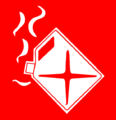
In fire classes, a Class B fire is a fire in flammable liquids or flammable gases, petroleum greases, tars, oils, oil-based paints, solvents, lacquers, or alcohols. [1] For example, propane, natural gas, gasoline and kerosene fires are types of Class B fires. [2] [3] The use of lighter fluid on a charcoal grill, for example, creates a Class B fire. [4] Some plastics are also Class B fire materials. [3]
Class B fires are distinguished from the other fire classes: Class A fires ("ordinary combustibles" such as wood, paper, or rubber); Class C fires (in which the burning material is energized electrical equipment) and Class D fires (in which the burning material is combustible metals). [3] The less-commonly-used Class F (known in the United States as Class K) refers to fires involving cooking oil or fat; these materials are technically part of Class B. [5]
Fires are classified by the proper extinguishing agent. While water is used on Class A fires, using water on a Class B fire (e.g., a grease fire) is extremely dangerous. [3] [5] This is because Class B fires typically have a fuel with a lower density than water (causing it to rise) and the burning fluid is hotter than the boiling point of water (212 °F or 100 °C). The resulting sudden rising of a column of flames together with droplets of boiling fuel and water is generally known as a slopover. [6] [7] For example, when water is placed on grease, it creates steam which expands rapidly and splatters burning droplets in a phenomenon causing burns and spreading the fire. [3] Because of this, Class A fire extinguishers use water, while Class B fire extinguishers use dry chemicals (foam or powder), [5] such as aqueous film-forming foam, multi-purpose dry chemicals such as ammonium phosphate, and halogenated agents (such as Halon 1301 and Halon 1211) [8] or highly pressurized carbon dioxide. [5] Some fire extinguishers contain chemicals designed to fight both Class A and Class B fires. [8]
Grease and cooking oil fires pose a greater safety risk. One ten-year study, examining the years 1976 to 1985, found that 4.7% of hospitalized burn patients suffered burns from hot grease or oil, with 78% of such injuries occurring in the home. [9] According to the National Fire Protection Association, between 2010 and 2014, nearly half (46%) of home structure fires reported to fire departments in the United States involved cooking; over the same time period, cooking equipment was implicated in 19% of home fire deaths, 44% of home fire injuries, and 17% of total direct property damage. [10] Grease fires are an object of study in food science. [11]
-
Class B fire icon
-
Combustible materials fire symbol
-
Other combustible materials fire symbol
See also
- Grease duct – a duct designed to vent grease-laden flammable vapors to prevent them from building up near the flame of cooking apparatuses
- Exhaust hood – a device containing a mechanical fan that for use above the stove or cooktop in the kitchen to remove airborne elements produced by cooking
- Ignitable Liquid Drainage Floor Assembly – an active fire protection system designed to respond to Class B fires inside infrastructure by removing flammable liquids into secondary containment
References
- ^ NFPA's Illustrated Dictionary of Fire Service Terms, p. 23 ( National Fire Protection Association/ Jones and Bartlett Publishers: 2006).
- ^ James R. Gillespie & Frank Flanders, Modern Livestock & Poultry Production, 8th ed. (Centgage Learning: 2009), p. 76.
- ^ a b c d e International Association of Fire Chiefs/ National Fire Protection Association, Fire Inspector: Principles and Practice ( Jones and Bartlett Publishers, 2012), pp. 204-06.
- ^ Robert H. Hill, Jr. & David C. Finster, Laboratory Safety for Chemistry Students (2d ed.: John Wiley & Sons, 2016).
- ^ a b c d JB Crippin, "Types of Fires" in Forensic Chemistry (ed. Max M. Houck: Academic Press, 2015), p. 219.
- ^ API (1991). Fighting Fires in and Around Flammable and Combustible Liquid Atmospheric Storage Tanks. API Publication 2021 (3rd ed.). Washington, D.C.: American Petroleum Institute. p. 29.
- ^ NFPA (2018). Flammable and Combustible Liquids Code. NFPA 30 (2018 ed.). Quincy, Mass.: National Fire Protection Association. p. 102. ISBN 978-145591661-0.
- ^ a b Lon H. Ferguson & Christopher A. Janicak, Fundamentals of Fire Protection for the Safety Professional (2d ed. 2015), pp. 203-04.
- ^ Schubert, Warren; Ahrenholz, David H.; Solem, Lynn D. (1990). "Burns from Hot Oil and Grease: A Public Health Hazard". Journal of Burn Care & Rehabilitation. 11 (6): 558–62. doi: 10.1097/00004630-199011000-00014. PMID 2286612.
- ^ Marty Ahrens, Home Fires Involving Cooking Equipment, National Fire Protection Association (November 2016).
- ^ Ingolf Gruen, Out of the Frying Pan and into the Grease Fire: A Case Study in Food Science, National Center for Case Study Teaching in Science, University at Buffalo (May 31, 2003).
External links
-
 Media related to
Class B fire at Wikimedia Commons
Media related to
Class B fire at Wikimedia Commons


